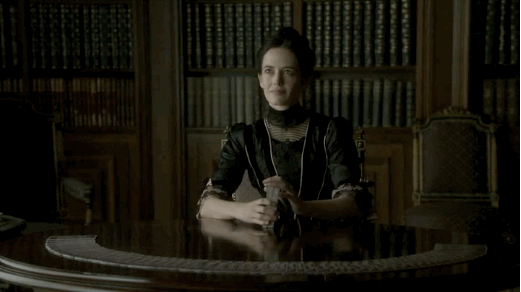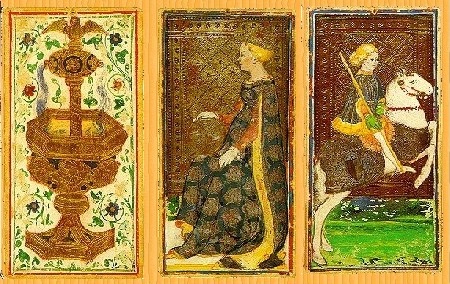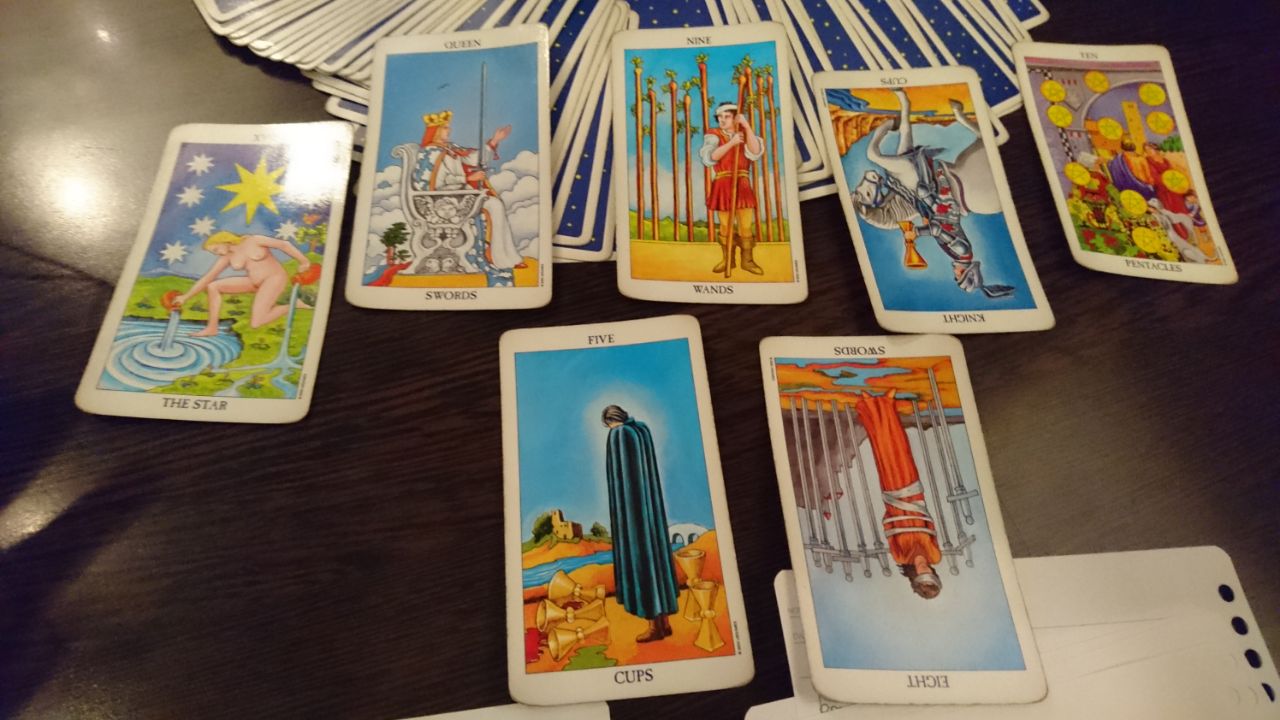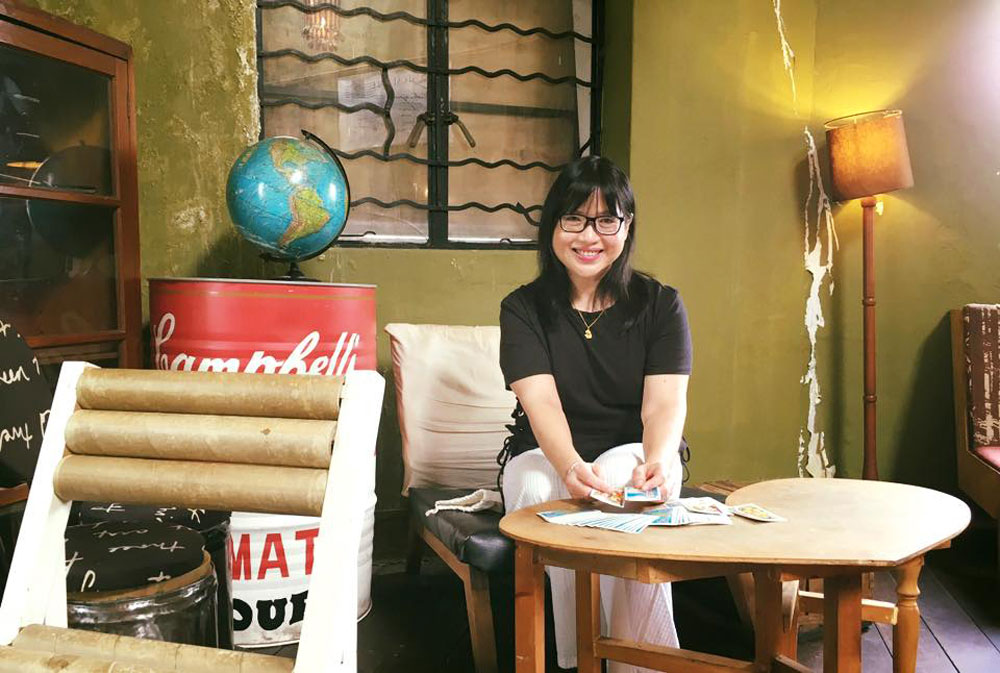The Roman Catholic Archdiocese of Singapore has issued a response to this article. Read it here.
When you think tarot cards, you'd think hocus-pocus.
And when you think tarot card readers? You'd most likely think of dark and haunted young women in goth clothing or wrinkled old crones with a taste for occult and magic.
This impression, not surprisingly, is all thanks to television, movies and pop culture in general.
Think Solitaire from the Bond film Live and Let Die, Vanessa Ives from Penny Dreadful, or even Paige and Phoebe from Charmed.
[caption id="" align="aligncenter" width="521"] GIF via [/caption]
GIF via [/caption]
You get the idea.
Tarot card reader in Singapore
Here to bust some myths about tarot cards and the professional readers is Joanna Ash.
The 49-year-old is from Sun Goddess Tarot in Singapore and has been giving professional tarot card readings since 2012.
Meeting Joanna in the flesh would reveal she is not a freak.
She is a normal person, with a normal lifestyle. In fact, she is so normal, she is a marketing specialist by day, and also a mother, a practising Catholic and a boxer.
In person, Joanna is completely down-to-earth -- far from being the stereotypical gyspy with an enigmatic personality.
She feels more like a friend, even though you might have barely met her.
And if she didn't tell you what she does, you wouldn't even have guessed.
And Joanna has a good reason for that.
"Metaphysicists need to not talk like metaphysicists. We need to talk like people -- normal people who have our own issues. I mean, we have our daily work issues, juggling commitments with family, so we’re not separate from all of you," she said matter-of-factly.
"A lot of people have the misconception that readers must be damn Zen. Light joss-stick and incense everyday. Meditate 20 times a day. Sit on a cushion, lotus position, all the time. We don’t. I’m a boxer. I’m very straight-talking, I don’t talk fluffy stuff, I make it quite plain and simple."
[related_story]
How she became a tarot card reader
When Joanna was a kid, she stumbled upon a book belonging to her father. The book was about cartomancy, which taught her about how tarot is used, and even how normal playing cards could be used for a reading.
Her mum, like any parent, wasn’t too happy about that. It was a Roman Catholic household, after all. Mother wasted no time telling her daughter to concentrate on studies, and that was that.
Joanna would grow up uneventfully like any other normal kid.
But of course, if that was the end of it, we wouldn’t have anything to write about, no?
Years later, Joanna would come into contact with tarot again. It happened after she started going to a tarot reader, whom she calls a "Tarot Master".
This Tarot Master accompanied Joanna through crossroads in her life, such as her divorce, her health issues and a low point in her career, by helping the seeker of advice and assistance make decisions going forward.
[caption id="" align="aligncenter" width="960"] Photo via Sun Goddess Tarot's Facebook page[/caption]
Photo via Sun Goddess Tarot's Facebook page[/caption]
Tarot was life
Joanna was hooked.
She wasn’t passively receiving readings, but became inquisitive. She picked up the meanings from the reader when she laid down the cards.
When the reader encouraged her to learn tarot initially, Joanna hesitated.
She recalled her mum’s words about how it would be a waste of her time to learn the craft.
Eventually, though, Joanna gave in and made a conscious decision to pursue it as a hobby, with the feeling that tarot could revitalise her, and possibly turn her life around.
Those are things that you don’t usually think of as outcomes from practising tarot. Such positive vibes supposedly from a “dark” deck of cards?
Not like the movies
Sorry to disappoint, fans of Hollywood, horror and the occult. Because in real life, you just won’t see a tarot card reader using the deck the way it is portrayed in the media.
[caption id="" align="aligncenter" width="500"] That one card that gets the bad rep. GIF via GIPHY[/caption]
That one card that gets the bad rep. GIF via GIPHY[/caption]
Joanna is quick to dismiss the idea that tarot cards are Satanic or influenced by religion or the occult.
According to Joanna, tarot cards are a set of pictures. And they need to be interpreted.
"Just like what I told you, ultimately you make your choices," Joanna said, probably for the umpteenth time in her life.
"It’s not Satanic, obviously, zero religion. There’s no religion attached to it. I interpret pictures, basically, I don’t pray to a card. That’s not what I do. So it’s very pure, simple."
She said that the cards have nothing religious about it, and it’s not even predictive. And it's definitely not fortune-telling.
This idea is already unlike what most people believe the tarot cards can do.
While this practice might be generally frowned upon by the larger Catholic community, Joanna insists she faces no issues nor conflicts with practising tarot and being religious.
Joanna explained: "I am a practising Catholic and my faith got stronger in the belief that my gifts, meant to help support others in their difficult times, are gifts that are God-given."
"It’s just like anyone else with the gift of counselling, tutoring, teaching, nursing. All these are gifts aligned to a calling to help others. My conscience is clear and I do it with the pure authenticity of serving others. That’s why I am so passionate about what I do."
Historical Trivia
Historically, the evidence supports what Joanna says.
Early historical information regarding the topic of tarot points to evidence that the cards began as playing cards -- the very same kinds we use for poker.
Tarot as a game was developed somewhere in the 15th century in Italy as trionfi (trump) cards.
From there, we can see the similarities of the characters depicted to that of the modern tarot: Emperors, Empresses, The Fool and even Death. They're likely to have been allegorical, or resembling events of the time.
They also looked super fancy, because they were commissioned by rich Italian families.
 Reproduction of three cards from the Pierpont-Morgan Bergamo Visconti-Sforza Deck. Picture via Wikimedia Commons
Reproduction of three cards from the Pierpont-Morgan Bergamo Visconti-Sforza Deck. Picture via Wikimedia Commons
[caption id="" align="aligncenter" width="359"] 2spooky4me. Early "Death" Trionfi card from the Pierpont-Morgan Bergamo deck, which was created in 1451. Picture via Wikimedia Commons[/caption]
2spooky4me. Early "Death" Trionfi card from the Pierpont-Morgan Bergamo deck, which was created in 1451. Picture via Wikimedia Commons[/caption]
However, it was only in the 19th century did the cards begin to be used and recreated by occult groups. It was branded as an occult divinatory method, which suggests that the occult was an association that was embellished onto the cards afterwards.
A large part of it is thanks to this French guy, Jean-Baptiste Alliette, who wrote his first book on the tarot in 1791. He linked tarot to Egyptian mysticism, which was trending at that point in time. But tarot, which was and still is, in France, seen as a card game.
The best part? The Rosetta Stone wasn't even deciphered at that point in time yet, so there's a good chance that Alliette was projecting some of his theories and half-truths onto tarot.
But thanks to Alliette, countless of people thereafter took to his thoughts, including the people behind one of the most prolific tarot decks, the Rider-Waite-Smith or Rider-Waite.
[caption id="" align="aligncenter" width="530"] The Rider-Waite or Rider-Waite-Smith Tarot deck. Photo via Wikimedia Commons [/caption]
The Rider-Waite or Rider-Waite-Smith Tarot deck. Photo via Wikimedia Commons [/caption]
This deck was illustrated by artist Pamela Coleman Smith, under the instructions of the then renowned occult academic A.E. Waite. It is used by many, including Joanna, up till today.
This tarot deck was meant for mainly divinatory purposes and alluded to the designs of older tarot cards, which as mentioned earlier, were likely allegorical.
The images of the Devil and Death are believed to echo that of religious narratives rather than the occult, as supported by other images such as Judgement and Temperance, which may have been inspired by traditional imagery in religion.
Waite also admittedly wrote that much of the minor arcana part of the deck (suits and pips) are pretty much limited in any esoteric purpose and had their meaning and illustrations mostly left up to the artist, Smith, to basically do whatever she felt fit for them.
Currently, the tarot reading culture worldwide has since evolved into one that is more open and free-association based, a departure from the wide-spread estoeric attitudes of the 19th century.
Trying is believing
[caption id="" align="aligncenter" width="480"] The only card that matters to some people - a pizza card. GIF via GIPHY[/caption]
The only card that matters to some people - a pizza card. GIF via GIPHY[/caption]
And if you're a sceptic?
Well, you’re more than welcome to speak to Joanna if you don’t get how tarot works.
Over the years, Joanna said she has seen her clients turn their lives around with tarot.
The people who come to her for readings include CEOs, accountants, and corporate types in general who are part of the Central Business District crowd.
Joanna said: “Those who didn’t see their lives turn around, and those who have never tried this, you can come to see me.”
But, of course, a caveat: A face-to-face reading with Joanna will set you back S$180.
For some people though, it’s worthwhile.
Why do people go to tarot readers?
One incident Joanna mentioned, stood out.
It involved a man who accompanied his younger sister to a tarot reading with Joanna, because he simply did not believe tarot is a real thing.
However, the man returned the next time by himself, alone -- which is validation for Joanna.
Joanna recounted: "This person came to see me. And I said, 'You look very familiar, you know'. He said, 'Yeah yeah, I was here sitting next to my sister because I actually didn’t want my sister to come and see you. I don’t believe in this sh*t. And my sister saw you like many months ago... and I just want to make sure that I’m here to protect her, in case you say something stupid that makes her break down'."
She continued: “'But when I saw what you’ve done with her, and how she has become over the last six months, how you have transformed her life, I decided I have to come and see you too'.”
"I was like. 'Okay, I felt quite good'."
I tried tarot card reading

Joanna's reading of me
The tarot card reading I was given can be described as a mid-point between counselling and having a heart-to-heart chat with a friend.
There was nothing predictive about tarot card reading. Joanna couldn't see into my future. Neither could she see into hers.
My stupid editor suggested before the interview to smack Joanna lightly and then ask her if she saw that coming. I highly suspected that was not how tarot works.
I was made to draw cards from the deck. The way the cards work is that it requires interpretation, after a question is asked.
Some aspects Joanna was spot on was how, from her reading, she was able to deduce that much of the issue I was facing came from my head.
Two of the cards that she drew had swords -- Queen of Swords and Eight of Swords, which suggests logic, intellect or thinking, and the other cards suggested that I was reeling in from their impacts.
I felt that it was true. I was told before that my lofty expectations was a problem. Joanna also demonstrated flexibility with her interpretation, which allowed her to give me a more meaningful reading.
For example, she was able to see that The Star wasn't a card of positivity as it usually was in my reading, but rather a reflection, of my lofty ideals and my attempts to rule my head and my heart.
Neither was the Ten of Pentacles, representing large gold coins, necessarily about material gains, but rather, an emotional fulfilment, which I could gain from reconciliation.
Other aspects, I felt, were not as spot-on were perhaps more towards the numerology aspect of it, something she uses before the reading, and concurrently with the reading to explore the advice she interprets from the cards with greater detail and relevance to me.
She told me I was a number 7, which once again points towards me as a thinker, and my enjoyment of working for things with meaning, rather than money.
But when she said that I was reliable, a structured person that was good at organising things... not so much.
Overall, it was a pleasant experience. I can understand why white-collar workers would turn to someone like Joanna for advice.
There is less stigma going to see a tarot card reader (will make you look quirky if someone found out) instead of going to see a professional shrink (then people will probably guess you must be really screwed up to go visit a psychiatrist for help.)
Tarot’s history will always cast a shadow over its present use, infamy and misconceptions.
However, more readers are like Joanna, who are creating a more inclusive and wholesome tarot culture. Or at least, spark meaningful and balanced discussions on the topic.
Top photo via Sun Goddess Tarot's Facebook page
If you like what you read, follow us on Facebook, Instagram, Twitter and Telegram to get the latest updates.
